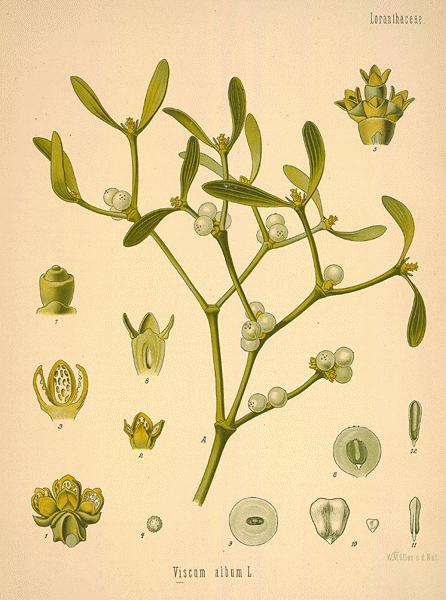Welcome to December and all the seasonal festivities and frivolities married to it! Few holidays have such a diverse number of traditions and customs. I mean, who came up these and why are they related to Christmas: eggnog, fruitcake, decorated conifers, socks on mantles, and swapping spit under mistletoe, just to name a few (and those are only the decidedly American holiday traditions. You should hear what they do in other countries!).
Actually, we did borrow the mistletoe thing from Britain, like most things which are so awesome and British. And the British being born gardeners, well, they know a thing or two about plants. What other culture would write a Christmas carol about holly and ivy? As the great global melting pot, not only do we often borrow foreign customs, we frequently take their plants, too. Viscum album, the native species found in Great Britain and much of Europe, having now been introduced to North America, is an evergreen plant with a woody stem which grows on and gets most of its nutrients from a host. It does photosynthesize a bit, but not much, which is what makes it a hemiparasite, and that's a compliment, really. The Latin name is likely derived from the sticky seed coating (viscum) and the color of the berries (from 'albus', meaning white).
The species native to Spain, Portugal, North Africa, Australia, and Asia is Viscum cruciatum (sounds like a Harry Potter spell, doesn't it?).
 |
| Potter Wiki (no nargles here) |
I kid you not, but it has nothing to do with Santa Claus. (Or does it? Nah.) Mistletoe is related to Sandalwood. It also happens to bloom and set fruit right around Christmas time when most other plants in the Northern Hemisphere are settling in for a long winter's nap. Once dissected, the common name is anything but complimentary. The name mistletoe comes from the Anglo Saxon word 'mistel' (which means dung, probably a reference to how the plant is propagated) and the Old English word 'tan' (which means twig). Roughly translated, mistletoe means 'poo on a stick'. Isn't that...special!
 |
| botanical.com |
Mistletoe has been known and used in Herbalism for centuries and parts of the plant were prized by many ancient cultures for their healing properties. The Greeks used it to cure everything from menstrual cramps to spleen disorders, while over in Rome, the naturalist Pliny the Elder noted its use as a balm against epilepsy, ulcers and poisons (ironic, since the berries are poisonous to humans).
The plant’s romantic associations most likely began with the Celtic Druids of the 1st century A.D. Since mistletoe can blossom even during the frozen months of winter, the Druids came to view it as a sacred symbol of vim and vigor, and it was administered to humans and animals alike in the hope of restoring fertility (again, poison! Raising eyebrows, here). The association with fertility and vitality persisted throughout the Middle Ages. Some considered it an aphrodisiac (Poison! Does no one listen!?) owing to the allegedly sexual nature of the plant: the Y-shaped branches, white sticky juice from pearl hued ball-shaped berries hinted of...let's not venture further...ok, lets. Ironically, it's the female plant that bears the poisonous fruit while the male plant is conspicuously berry-less. Let your Freudian brain puzzle that one out over a mug of 'nog for a while.
By the 18th century mistletoe had become incorporated into Christmas celebrations around the world. The 'downstairs' class of Victorian England is credited with first recording the tradition of kissing underneath the mistletoe. Taking their cue from the Druids' and their fertility rituals, the tradition of kissing beneath the mistletoe dictated that a man was allowed to kiss any woman standing underneath the boughs, and should any woman refuse the overture, ill luck would befall her. Another variation on the tradition stated that with each kiss a berry was to be plucked from the mistletoe, and when all the berries were gone, the smooching must cease. Many a serving maid scurried into hiding when the mistletoe was hung, as described by nineteenth century writer Washington Irving: "the mistletoe, with its white berries, hung up, to the imminent peril of all the pretty housemaids."
 |
| www.chron.com |
So while you're enjoying the eggnog and petrified fruitcake at your next holiday gathering, keep an eye out for halls decked out with that most romantic of evergreens, pucker up, and whisper seductively to your sweetheart, "Osculate me under the obligate hemiparasite". That'll get hearts racing, I guarantee it!





No comments:
Post a Comment